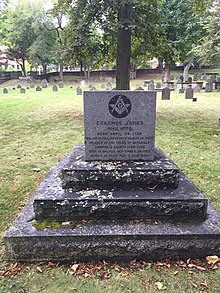Erasmus James Philipps

Erasmus James Philipps (23 April 1705 – 26 September 1760) was the second longest serving member on
Career

Philipps was born in
He was then posted to Canso with the 40th Regiment (1728). He was appointed to be Advocate for the Vice Admiralty Court in Nova Scotia (1729-1749). He became the secretary for the Nova Scotia Council (1731-1760). He was asked by the Board of Trade to assist in settling boundary disputes between Massachusetts Bay and New Hampshire as well as Massachusetts Bay and Rhode Island. He became a
During King George’s War, Philipps looked after providing accommodation and supplies for the troops during the Battle of Grand Pré (1747). He survived the French attack and returned to Annapolis Royal. When the provincial legislature was reorganized in 1749, Philipps was named to the new Council.
He arranged the
Legacy
- namesake of the Grand Lodge of Nova Scotia's medallion (1921).
See also
References
- ^ Richard Bulkeley was the longest serving member of the Nova Scotia Council (1749-1800).
- ^ Annapolis Royal Minutes 24 Oct 1726
- ^ "Annapolis Royal Heritage Society". Archived from the original on 2016-11-05. Retrieved 2016-11-05.
Further reading
- John Doull. Erasmus James Philipps. Founder of Freemasonry in Canada. Grand Historian, Grand Lodge of Nova Scotia
- Godfrey, William G. (1974). "Philipps, Erasmus James". In Halpenny, Francess G (ed.). Dictionary of Canadian Biography. Vol. III (1741–1770) (online ed.). University of Toronto Press.
